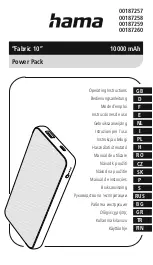
20
English
Step II:
Medium pendulum action;
Step III:
Large pendulum action�
It is recommended to consider the following rec-
ommendations when selecting the degree of the
pendulum rate:
•
when the edge of the saw cut must be exact and
clean, select small pendulum rate or switch the pen-
dulum rate off;
•
switch the pendulum rate off when processing thin
(sheet metal, sheet plastic, etc�) or hard materials
(alloy-free steel, non-ferrous metals, etc�);
•
when sawing soft materials (soft wood, etc�) se-
lect large pendulum rate; it will increase the speed
of the operation, however the quality of the saw cut
may be reduced�
It is recommended to make a test saw
cut using a spare piece of the blank part
(made of the same material as the blank
part to be processed) after the pendulum
rate is selected.
Protection against contact with saw blade
Contact protector
6
prevents accidental contact with
saw blade
17
and improves safety of work performance�
Plastic overlay
Plastic overlay
14
of the base plate
13
prevents
damage the surface of treated workpiece�
LED lamp
LED lamp
10
allows to carry out works in low light
conditions�
•
Set on / off switch
3
in the "ON" position to switch on
the LED lamp
10
�
•
Set on / off switch
3
in the "OFF" position to switch
off the LED light
10
�
Recommendations
on the power tool operation
Selecting the saw blade
Saw blades 17 of T-type may be used
with all of the jigsaw models.
Before starting the operation, please select the appro-
priate type of the saw blade
17
which should corre-
spond to the sawed material, sawing regime and the
quality of the edge of the saw cut� The designation of
the saw blade is printed on the package; you may also
ask the salesperson�
General guidelines for cutting
Make a test saw cut using a spare piece of
the blank part (made of the same material
as the material of the blank part) in order
to make sure that the saw blade 17, the
sawing speed and the pendulum strike have been
selected appropriately.
•
Make sure that the blank part is tightly fastened and
that all of the metal pieces (nails, screw nails, etc�)
have been removed from it�
•
Turn the power tool on before the saw blade
17
comes
in contact with the blank part� Do not use extra force; the
operation requires some time� Extra force will not speed
up the operating process, but it will overload the tool�
•
When the teeth of the saw blade
17
are too large
for the blank part (excessive vibration, splitting and
chipping of the processed surface will serve as a sign
of the teeth being too large), turn off the power tool
immediately and replace the saw blade
17
with the ap-
propriate blade�
•
If the saw blade
17
jams during the operation, turn
off the power tool immediately and try to expand the
saw cut, then carefully remove the saw blade
17
from
the saw cut�
• After the cutting is finished, first turn the power tool
off and then remove the saw blade
17
from the saw
cut�
When cutting certain materials (like met-
als), the saw blade 17 may heat up ex-
cessively, therefore it is recommended
to use cooling or lubricating substances
which are to be applied to the point where the saw
blade 17 comes in contact with the blank part.
Plunge sawing (see fig. 5)
Plunge sawing may be used only when
sawing soft materials, such as wood,
plasterboard, etc. This operating tech-
nique facilitates sawing the holes
without preliminary drilling - the saw blade 17 cuts
through the blank part on its own. This technique
requires certain skill and may be applied using
short saw blades 17.
•
Position the power tool on the front edge of the base
plate
13
(see fig. 5) and turn it on. Slowly plunge the
blank part with the saw blade
17
by pressing the power
tool to the blank part�
•
Once the saw blade
17
cuts through the blank part
return the power tool into its normal operating position
and continue cutting along the marked line�
Parallel sawing (see fig. 6)
Parallel sawing allows cut of workpiece along the exist-
ing straight edge as well as cutting straight bars of the
same width (see fig. 6).
•
Install a straight board to a workpiece and set the
needed sawing distance (distance "a" onto figure 6).
•
Fix the board with screw clamps and use it as limit
stop�
•
Perform sawing by moving power tool along the
board while pressing the side of base plate
13
to the
side of the board�
Cutting angle adjustment (see fig. 7)
The design of the power tool facilitates making
angled saw cuts by angling the case of the power
Содержание STS06-65 DV
Страница 1: ......
Страница 5: ...5 ...
Страница 6: ...6 ...
Страница 7: ...7 ...
Страница 133: ...133 ...
Страница 134: ...134 ...
Страница 135: ...135 ...
Страница 136: ...136 ...
Страница 137: ...137 ...
Страница 138: ...138 ...
Страница 139: ...139 ...
Страница 140: ...140 ...
Страница 141: ...141 ...
Страница 142: ...142 ...
Страница 143: ...143 ...
Страница 144: ...144 ...
Страница 145: ...145 ...
Страница 146: ...146 ...
Страница 147: ...147 ...
Страница 148: ......
















































